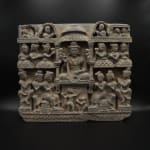Gandharan Schist Relief Depicting a Scene from the Life of the Buddha Maitreya, 100 - 300 CE
31.8 x 36.8 cm
12 1/2 x 14 1/2 in
12 1/2 x 14 1/2 in
LI.3307
Further images
-
(View a larger image of thumbnail 1
)

-
(View a larger image of thumbnail 2
)

-
(View a larger image of thumbnail 3
)

-
(View a larger image of thumbnail 4
)

-
(View a larger image of thumbnail 5
)

-
(View a larger image of thumbnail 6
)

-
(View a larger image of thumbnail 7
)

-
(View a larger image of thumbnail 8
)

-
(View a larger image of thumbnail 9
)

-
(View a larger image of thumbnail 10
)

-
(View a larger image of thumbnail 11
)

This remarkable and rare schist relief depicts the future Buddha Maitreya, a common theme in Gandharan narratives. The Buddha, shown in the centre, is seated in padmāsana–the lotus pose, while...
This remarkable and rare schist relief depicts the future Buddha Maitreya, a common theme in Gandharan narratives. The Buddha, shown in the centre, is seated in padmāsana–the lotus pose, while his right hand is in abhyamudrā, and his left is holding a flask (kalaśa, kamandalu)--the iconographical attribute of the Buddha Maitreya. Typical of Gandharan Maitreyas, he is seen here with a double looped knot, and a pear-shaped jewel at the centre of the knot, as well as wearing earrings and a necklace. The Buddha is seated on a throne in paradise (Tusita heaven), a canopy shading him and two balconies flanking his sides. He is surrounded by both male and female figures, sitting in European fashion (bhadrāsana) venerating him and providing offerings. Tusita, or paradise scenes preceding the Buddha’s birth are relatively rare, and this example provides stunning details of each of Buddha’s venerators as well as the subtle architectural features of Tusita.
The Buddha Maitreya is considered to be the Buddha Shakyamuni's successor, as is written in the canonical Pali texts. It is said that at the time of Maitreya’s reign as Buddha, people will live to be 80,000 years old, and ruled under a King called Sankha in the royal city Ketumatī. This era will also mark a utopian time when people will no longer need to work and will live in harmony with one another. Many Buddhists, especially Theravada Buddhists regularly pray to be reborn when Maitreya descends to become enlightened. The cult of Maitreya played a large role within the Kushan Empire, but largely disappeared after its fall to be replaced by the widespread sect of Mahāyāna Buddhism.
Gandhara’s geographical position, situated between the Persian world to the west and the Indian to the east, ensured that it was open to a wide variety of artistic influences. Often described as a ‘cultural melting pot,’ its strategic importance left it vulnerable to attack. Briefly in the hands of Alexander the Great between 327 -326 B.C., Greek artistic conventions long played an important role in local production. However whilst Gandhara clearly came under the influence of an extraordinary wide range of outside influences, it was also an exporter of ideas. This is most apparent in relation to the spread of Buddhism from India into other parts of Asia. Gandharan monks and scribes were particularly active in areas of China. According to tradition Buddhism was first introduced into the Gandharan region under the patronage of Asoka, emperor of the Mauryan dynasty, in the third century B.C. The first significant physical remains to survive, including stupas and figurative sculpture, date from the first century B.C. Between c.100-400 A.D. sculptors working in schist, terracotta and stucco produced an astonishing number and variety of Buddhist images. (LI.3307 FA).
The Buddha Maitreya is considered to be the Buddha Shakyamuni's successor, as is written in the canonical Pali texts. It is said that at the time of Maitreya’s reign as Buddha, people will live to be 80,000 years old, and ruled under a King called Sankha in the royal city Ketumatī. This era will also mark a utopian time when people will no longer need to work and will live in harmony with one another. Many Buddhists, especially Theravada Buddhists regularly pray to be reborn when Maitreya descends to become enlightened. The cult of Maitreya played a large role within the Kushan Empire, but largely disappeared after its fall to be replaced by the widespread sect of Mahāyāna Buddhism.
Gandhara’s geographical position, situated between the Persian world to the west and the Indian to the east, ensured that it was open to a wide variety of artistic influences. Often described as a ‘cultural melting pot,’ its strategic importance left it vulnerable to attack. Briefly in the hands of Alexander the Great between 327 -326 B.C., Greek artistic conventions long played an important role in local production. However whilst Gandhara clearly came under the influence of an extraordinary wide range of outside influences, it was also an exporter of ideas. This is most apparent in relation to the spread of Buddhism from India into other parts of Asia. Gandharan monks and scribes were particularly active in areas of China. According to tradition Buddhism was first introduced into the Gandharan region under the patronage of Asoka, emperor of the Mauryan dynasty, in the third century B.C. The first significant physical remains to survive, including stupas and figurative sculpture, date from the first century B.C. Between c.100-400 A.D. sculptors working in schist, terracotta and stucco produced an astonishing number and variety of Buddhist images. (LI.3307 FA).










